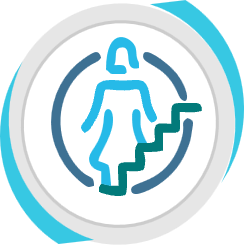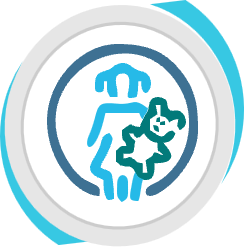10.10 Gender Statistics#
10.10.1 Context: the need for gender statistics#
Beijing Declaration and Platform for Action, 1995, United Nations
The Beijing Declaration and Platform for Action (🔗) was adopted at the Fourth World Conference on Women and held in Beijing in 1995. It recommended that national, regional and international statistical services should ensure that statistics related to individuals are collected, compiled, analysed and presented by sex and age and reflect problems, issues and questions related to women and men in society.
Twenty-five years on, its stature and significance as a roadmap for the achievement of gender equality remain undiminished. This pivotal document continues to guide the global struggle against constraints and obstacles to the empowerment of women around the world. It underpins the formulation of a framework for gender statistics.
It identifies 12 domains:
The 2030 Agenda for Sustainable Development
Achievement of gender equality is also inextricably linked and contributes to all spheres of the 2030 Agenda for Sustainable Development (🔗). Goal 5 explicitly calls for gender equality and empowerment of women and girls, and around one-third of the 231 SDG indicators, covering 14 different goals, are identified as gender-relevant by the Inter-Agency and Expert Group on Gender Statistics. Thus, countries are asked to provide sex-disaggregated data wherever applicable when reporting on the progress made towards achieving the Sustainable Development Goals.
In addition to the Beijing Declaration and 2030 Agenda, national development strategies create new demands for gender statistics. Policymakers, researchers and advocates voice the need for more high-quality gender data and argue that the gender perspective should be a basic guiding assumption to plan, formulate and monitor inclusive and evidence-based policies and programmes at the national level. In 2010 the UNECE and the World Bank prepared Developing Gender Statistics: A Practical Tool (🔗). This manual (which is further discussed in Chapter 10.10.4 — Guidelines for the production and use of gender statistics) guides statistical organizations in the production and public use of statistics.
10.10.2 Concepts and definitions#
Gender statistics are defined as statistics that adequately reflect the differences and (in)equalities in the situation of women and men, girls and boys.
They cover a broad diversity of topics and issues, reflecting the ever-changing roles of women and men in society and public life, in the economy, and in families and households. They help policymakers to formulate policies and plans, monitor changes, and inform the public.
More specifically, gender statistics should reflect gender issues, that is, questions, problems and concerns related to all aspects of women’s and men’s lives, including their specific needs, opportunities and contributions to society. In every society, there are differences between what is expected, allowed and valued in a woman and what is expected, allowed and valued in a man. These differences have a specific impact on women’s and men’s lives throughout all life stages and determine, for example, differences in health, education, work, family life or general well‐being. Producing gender statistics entails disaggregating data by sex and other characteristics to reveal those differences or inequalities and collecting data on specific issues that affect one sex in particular or relate to gender relations between women and men.
As noted in Integrating a Gender Perspective into Statistics, 2016, UN (🔗), concepts and definitions used in data collection must be developed in such a way as to ensure that the diversity of various groups of women and men and their specific activities and challenges are captured. In addition, data collection methods that induce gender bias in data collection, such as underreporting of women’s economic activity, underreporting of violence against women and undercounting of girls, their births and their deaths should be avoided.
In summary, gender statistics are defined by the sum of the following characteristics:
Data are collected and presented by sex as a primary and overall classification;
Data reflect gender issues;
Data are based on concepts and definitions that adequately reflect the diversity of women and men and capture all aspects of their lives;
Data collection methods take into account stereotypes and social and cultural factors that may induce gender bias in the data.
Difference between ‘gender’ and ‘sex’
Confusion between ‘sex’ and ‘gender’ still persists among both producers and users of statistics. The difficulty of translating the term gender from English into other languages further contributes to the confusion. Sometimes categories of sex (male and female) and gender (masculine and feminine) are treated as if they were the same thing. However, the word ‘sex’ refers to biological differences that define persons as women and men. Biological differences are relatively fixed and tend not to vary across cultures or over time. ‘Gender’, meanwhile, refers to socially constructed differences in the attributes and opportunities associated with being female or male, and to social interactions and relationships between women and men. Gender determines what is expected, allowed and valued in a woman, or man and should be further measured in the broader context of gender identity[1].
When data on demographic, social or economic characteristics are collected in the field, it is the sex of a person that is recorded, e.g., as female (woman) or male (man), not the gender. However, when analysed, data disaggregated by sex can reveal differences and (in)equalities in women’s and men’s lives that are the result of gender roles and expectations.
Analytical framework
There is no single overarching analytical framework for gender statistics. However, there are international guidelines for their production and use (as elaborated in the next section) and there are commonly held strategic objectives to expand gender statistics to cover all the important issues and to integrate them into mainstream statistical production.
10.10.3 Indicator frameworks and guidelines for production and use of gender statistics#
Global Minimum Set of Gender Indicators, 2013, UNSD
The Global Minimum Set of Gender Indicators (🔗) was agreed by the UNSC in 2013 as a guide for national production and international compilation of gender statistics. It is a collection of 52 quantitative indicators and 11 qualitative indicators covering national norms and laws on gender equality. It includes indicators covering domains such as education, employment, health, the human rights of women and girls, and public life and decision-making.
The choice of indicators was guided by the primary criterion that indicators should address key policy concerns as identified in the Beijing Platform for Action and other more recent international commitments. The list of Minimum Set of Gender Indicators has been revised to be fully aligned with the SDG indicators.
Indicators of Gender Equality, 2015
This UNECE publication Indicators of Gender Equality (🔗) is recommended for use in countries participating in the Conference of European Statisticians (CES). It was developed by a CES task force and endorsed by CES in October 2014. It presents a set of 115 gender equality indicators. The criteria for selection were that an indicator:
clearly addresses a relevant policy issue related to gender equality and/or women’s empowerment;
is relevant to the CES member countries;
is conceptually clear, easy to interpret, and has an agreed international definition;
is sensitive to changes, and changes in the value of the indicator have a clear and unambiguous meaning;
is feasible, robust and reliable;
is comparable over time and enables international comparison.
The indicators are grouped into eight thematic domains inspired by the Beijing Platform for Action and categorized into 42 headline indicators and 73 supporting indicators.
The headline indicators cover the essential aspects. Their purpose is to provide simple and clear information to decision‐makers, and the public about progress towards internationally agreed gender‐related policy objectives.
The supporting indicators provide further information on more specific aspects of gender equality. They are valuable to achieve a deeper comprehension of the phenomenon.
The indicator set is fully aligned with the Global Minimum Set of Gender Indicators.
Gender Statistics, ESCAP
The core set of gender indicators for Asia and the Pacific (🔗) developed by ESCAP adapts and extends the global minimum set of gender indicators to focus on the key issues for gender equality in the region. This core set is providing a basis for national policy development and for measuring and monitoring progress towards the achievement of gender equality and other global gender-related goals.
ESCAP also seeks - in the longer term - to assist the Member States through a regional programme on gender statistics (🔗), to build their capacity to collect the gender-sensitive data required to provide the proper foundation for such indicators.
CARICOM GEI, CARICOM RSP and UN Women Multi-Country Office - Caribbean
The CARICOM Regional Statistics Programme (RSP) and the UN Women Multi-Country Office (🔗) – Caribbean launched a collaborative endeavour in early 2015. The main goal of this initiative was to develop a set of CARICOM gender equality indicators (GEI) parallel to the global Minimum Set of Gender Indicators described in Chapter 10.10.3 — Indicator frameworks and guidelines for production and use of gender statistics Minimum Set of Gender Indicators, 2013, UNSD to identify, assess, measure and track persistent gender equality concerns and disparities across the CARICOM region, in accordance with the newly adopted SDGs. The CARICOM GEI framework was validated, and the indicators agreed upon at the 40th meeting of the Standing Committee of Caribbean Statisticians (SCCS) in 2015. In 2017, the CARICOM GEI were piloted in Dominica, Grenada, Jamaica and Suriname.
10.10.4 Guidelines for the production and use of gender statistics#
Developing Gender Statistics: A Practical Tool, 2010
The UNECE and World bank publication Developing Gender Statistics: A Practical Tool (🔗) aims to guide statistical organizations in the production and use of gender statistics. It presents a consolidated reference for any organization or individual interested in producing information about gender differences, guides producers of gender statistics and assists in improving the availability of high-quality information on women and men.
United Nations Guidelines for Producing Statistics on Asset Ownership from a Gender Perspective, 2018
The UN Guidelines for Producing Statistics on Asset Ownership from a Gender Perspective (🔗), prepared by the UNSD and UN Women provides national statistical agencies and policymakers with guidance on collecting, processing, analysing and disseminating individual-level data on asset ownership to inform three broad sets of policy issues: fostering the empowerment of women; reducing poverty and vulnerability; and understanding livelihoods.
The Guidelines introduce concepts, definitions and data requirements for measuring asset ownership from a gender perspective in household surveys and provide guidance on planning, organizing and implementing a household survey, appending a module, or adding a minimum set of questions on asset ownership to a nationally representative household survey. National statistical offices may choose a particular modality for the implementation of the recommendations, depending on their own needs and capabilities, including the needs of data users and the availability of data from other sources, such as administrative records.
The associated e-learning course (🔗) translates key concepts and recommendations from the Guidelines in an interactive manner. The course covers the conceptual framework, data sources, implementation guidance and data processing, analysis and dissemination.
United Nations Guide to Producing Statistics on Time Use: Measuring Paid and Unpaid Work, on-going, UNSD
Since 2018, the UNSD and the Expert Group on Innovative and Effective Ways to Collect Time-Use Statistics have been working towards the implementation of the International Classification of Activities for Time-Use Statistics (ICATUS 2016) and the modernization of time-use surveys, in the context of updating the Guide to Producing Statistics on Time Use: Measuring Paid and Unpaid Work and with the overall objective of further promoting this critical data collection across countries and over time.
The updated Guide aims to provide national statistical offices and policymakers with recommendations and best practices for collecting, processing, analysing and disseminating time-use statistics to inform research and the development of a broad range of policies, including on unpaid work and non-market production, well-being and gender equality. The guidelines will introduce key concepts and definitions related to time-use data and provide national statistical offices with advice on the different phases and processes to follow (data needs, design, build, collect, process, analyse, disseminate and evaluate) when implementing a household survey or appending a module on time-use to a nationally representative household survey. By exploring ways to modernise the collection of time-use data, including through the use of technology, the guidelines will ensure that national statistical offices have access to a sustainable model to institutionalize the systematic collection of those data. The updated Guide will build on the Guidelines for Harmonizing Time-Use Surveys, published by the Economic Commission for Europe in 2013 (🔗).
10.10.5 Using gender statistics: examples of assessments of progress towards gender equality#
Turning promises into action: gender equality in the 2030 Agenda for Sustainable Development, 2018
The flagship report on Turning promises into action: gender equality in the 2030 Agenda for Sustainable Development (🔗), by UN Women, monitors global and regional trends in achieving the SDGs for women and girls based on available data, and it provides practical guidance for the implementation of gender-responsive policies and accountability processes. As a source of high-quality data and policy analysis, the report is a key reference and accountability tool for policymakers, women’s organizations, the UN system, and other stakeholders. It lays the basis for robust, gender-responsive monitoring of the 2030 Agenda for Sustainable Development by:
showing how gender equality is central to the achievement of all 17 SDGs and arguing for an integrated and rights-based approach to implementation;
explaining gender data gaps and challenges for robust monitoring and establishing starting points and trends across a range of gender-related indicators based on available data;
providing concrete guidance on policies to achieve two strategic targets under SDG 5 (violence and unpaid care) and outlining how these policies are synergistic with other goals and targets; and
setting an agenda for strengthening accountability for gender equality commitments at global, regional, and national levels.
Women and the Sustainable Development Goals (SDGs), 2019, UN Women
Women and the Sustainable Development Goals (SDGs), by UN Women, showcases the above report (Turning promises into action.) It stresses that gender equality is a right and fulfilling this right is the best chance of meeting some of the most pressing current challenges, from the economic crisis and lack of health care, to climate change, violence against women and escalating conflicts. Women are not only more affected by these problems, but also possess ideas and leadership to solve them.
Progress of the World’s Women 2019-2020 Families in a changing world, UN Women
The UN Women report on Progress of the World’s Women 2019-2020 Families in a changing world (🔗) assesses the reality of families in the context of sweeping economic, demographic, political, and social transformation. The report features global, regional, and national data. It also analyses key issues such as family laws, employment, unpaid care work, violence against women, and families and migration. It relies on a broad array of available data as of March 2019, gathered from national sources, and compiled and harmonized by international agencies.
The World’s Women reports, UNSD
The UNSD World’s Women reports (🔗) are prepared at five-year intervals. The first was in 1990. The first three and 2010 edition analyse women’s situation compared to men’s worldwide in a broad range of fields. The 2005 edition reviews and analyses national capacity to collect and report sex-disaggregated data on socioeconomic topics relevant for addressing gender concerns. The most recent, 2015 edition comprises eight chapters covering critical areas of policy concern: population and families, health, education, work, power and decision-making, violence against women, environment, and poverty. In each area, a life-cycle approach is introduced to reveal the experiences of women and men during different periods of life-from childhood and the formative years, through the working and reproductive stages, to older ages.
Selected Statistics about Women and Men in Suriname, General Bureau of Statistics
The publication commenced in 2002 with 37 indicators under the name ‘Selected Gender Statistics’. In 2017 (after piloting the CARICOM Gender Equality Indicators) the name was changed to ‘Selected Statistics about Women and Men in Suriname’ (🔗). The statistics have been published in all the odd years since 2005 and included 142 indicators in 2019. The publication is one of the outputs of a UNSD/CARICOM Project (which became a CARICOM Program) on Strengthening Capacity in the Compilation of Statistics and Indicators for Conference Follow-up. Indicators are grouped under various headings, e.g., Education, Population, Health, Employment and Unemployment, Public Governance and Crime. Gender Statistics (odd years) and Environment Statistics (even years) are the responsibility of the Research and Planning Division of the General Bureau of Statistics of Suriname.
10.10.6 Examples of national practices#
Standard Question Modules for Sex and Gender, Australian Bureau of Statistics
The Australian Bureau of Statistics Standard Question Modules for Sex and Gender (🔗) specifies the mandatory elements and the allowable variations and optional inclusions in asking the questions ‘What is your sex?’ and ‘What is your gender?’
Gender workplace statistics at a glance, Australia
The Gender workplace statistics at a glance (🔗) publication by the Australian Workplace Gender Equality Agency brings together statistics from a variety of sources on women’s workforce participation, economic security, educational attainment, paid parental leave and leadership roles.
Guidance for questions on sex, gender identity and sexual orientation for the 2019 Census Rehearsal for the 2021 UK Census
The UK Office for National Statistics has provided Guidance for questions on sex, gender identity and sexual orientation (🔗) for the 2019 Census Rehearsal, accompanied by a summary of the research that informed the drafting of the guidance.
Gender-based Analysis plus (GBA+), Statistics Canada
GBA+ is an analytical process used in Canada to assess the differential effects of policies, programs, and legislation on diverse groups of women, men, and people of all sexual orientations, gender identities and expressions. In 2015, the Government of Canada strengthened the application of GBA+ across federal governments to support the development of evidence-based policies and programs that benefit everyone in the country. GBA+ also provides the foundation for gender-based budgeting, to ensure the effects of budget proposals on different groups of people are understood and addressed through more effective and inclusive priority setting and decision making. Statistics Canada is supporting GBA+ and gender-based budgeting by providing data disaggregated by sex, gender and other intersecting characteristics and quantitative analyses on a broad range of social, economic and environmental subject matter areas. To fill these roles, Statistics Canada created the Centre for Gender, Diversity and Inclusion Statistics (🔗) in 2018.
The Gender Equality Barometers, Statistics Finland
Coordinated by the Centre for Gender Equality Information, a national information service that provides information related to gender equality and gender studies, and conducted by Statistics Finland, the Gender Equality Barometers provide information on opinions, attitudes and experiences related to gender equality in various areas of life in Finland. They enable monitoring the development of gender equality in different sectors of Finnish society.
Gender Statistics Program, Uganda Bureau of Statistics
The Uganda Bureau of Statistics (UBS) has developed a comprehensive gender statistics program (🔗). One of the starting points was the National Governance Peace and Security Survey 2017 (🔗), which was a baseline survey of perceptions on violence against women, women’s economic empowerment and women’s political participation and leadership.
10.10.7 Further Development#
There are several international programmes aimed at further development of gender statistics and their integration within the regular statistics produced by NSOs. In this subsection, programmes that primarily focus on further development guidelines and indicators are described. The following section (Chapter 10.10.8 — Mainstreaming a gender perspective into official statistics) discusses programmes specifically promoting integration of gender statistics into regular statistical programmes.
UN Global Gender Statistics Programme (GGSP)
The Global Gender Statistics Programme (🔗) is mandated by the United Nations Statistical Commission (UNSC), implemented by the United Nations Statistics Division (UNSD) and partners, and coordinated by the Inter-Agency and Expert Group on Gender Statistics (IAEG-GS). The Programme encompasses:
improving coherence among existing initiatives on gender statistics through international coordination;
developing and promoting methodological guidelines in existing domains as well as in emerging areas of gender concern;
strengthening national statistical and technical capacity for the production, dissemination and use of gender-relevant data; and
facilitating access to gender-relevant data and metadata through the minimum set of gender indicators for national production and international compilation (adopted in 2013 by the UNSC).
Inter-Agency and Expert Group on Gender Statistics (IAEG-GS)
The Inter-Agency and Expert Group on Gender statistics (IAEG-GS) brings together representatives of international agencies within and outside United Nations system, statisticians from national statistical systems, and development partners, to review progress and provide guidance on future activities geared at advancing gender statistics. The United Nations Statistics Division (UNSD) is the secretariat of the group. The IAEG-GS is mandated by the UNSC to:
serve as the coordination mechanism for the Global Gender Statistics Programme;
provide guidance for the development of manuals and methodological guidelines for the production and use of gender statistics.
The IAEG-GS was first convened in 2006, meets annually and functions through advisory groups. The Group reviews methodological developments to measure and monitor gender indicators, shares best national practices in measuring and monitoring gender equality and takes stock of on-going and planned activities on gender statistics to improve coherence among existing and planned global and regional initiatives on gender statistics.
UNSD organizes Global Fora on Gender Statistics biannually under the Global Gender Statistics Programme and the guidance of the IAEG-GS. The Fora bring together producers and users of gender statistics from national and international statistical offices, other government agencies, international organizations, academia, civil society and the donor community to discuss and exchange best practices and innovations implemented across the globe to improve gender data and evidence for gender policies.
UNECE Steering Group on Gender Statistics
The objective of the UNECE Steering Group on Gender Statistics (🔗) is to provide direction to the Conference of European Statisticians (CES) work on gender statistics, to advance methodological work, capacity development, and collaboration between users and producers of gender statistics, and to follow up the implementation of CES guidance. The Steering Group:
coordinates the CES work on gender statistics;
launches and steers the development of guidelines and surveys of best practice;
oversees the work of CES task forces in the area of gender statistics;
follows up the implementation of CES methodological guidance related to gender statistics in UNECE countries;
acts as an organizing committee for UNECE Work Sessions on Gender Statistics;
advises the UNECE Secretariat on the formulation and planning of capacity-development activities to support the integration of a gender perspective into statistical systems in countries of Eastern Europe, Caucasus and Central Asia;
promotes the use of UNECE training materials in gender statistics; and
advances collaboration between users and producers of gender statistics.
10.10.8 Mainstreaming a gender perspective into official statistics#
Integrating a Gender Perspective into Statistics, 2016
While many countries are attempted to establish or have succeeded in establishing sound gender statistics programmes, additional guidance is needed to improve the availability of data and to ensure a proper mainstreaming of gender issues in all areas of official statistics. This UNSD manual Integrating a Gender Perspective into Statistics (🔗), which is targeted primarily at statisticians working in less developed NSSs, provides information needed to accomplish three main goals:
to achieve comprehensive coverage of gender issues in data production activities;
to incorporate a gender perspective into the design of surveys or censuses, by taking into account gender issues and avoiding gender biases in measurement; and
to improve data analysis and data presentation and to deliver gender statistics in a format that is easy to use by policymakers and planners.
Mainstreaming a gender perspective in statistics means that gender issues and gender‐based biases are systematically taken into account in the production of all official statistics and at all stages of data production. Gender statistics produced as an ‘add‐on’ are often marginalized and may not reach the full range of potential users, including policymakers in domains other than gender equality, analysts and researchers. Moreover, their production may be more dependent on irregular funding. Mainstreaming may also lead to more efficient coverage of gender issues and better coordination among data collection programmes in producing gender statistics.
Leadership: mainstreaming a gender perspective requires political will at all levels, throughout the NSS. Sensitizing and raising the awareness of both users and producers of data is critical in linking gender statistics to policies. NSO heads should be fully involved in the required capacity‐building and leadership.
Legal framework: of crucial importance to improving the availability of gender statistics is the specification of formal requirements for sex‐disaggregation and the incorporation of a gender perspective within the national statistical legislation that regulates the production and dissemination of official statistics. Requirements need to be established not only for statistics officially collected by the NSO but also for other NSOs and even organizations in the private sectors.
Cooperation between users and producers of statistics: efforts should be made to promote dialogue and understanding between statisticians and the various users of statistics -policymakers, representatives of non-governmental organizations, activists and researchers. This enables data users to understand, gain access to and use gender statistics more effectively and help to increase the capacity of statisticians to identify and understand gender issues and to produce and communicate data that better address user needs.
Collaboration in developing and improving concepts and methods: NSO need to work with international and regional organizations and agencies and academic and research institutions to mainstream gender in the development and revision of concepts, definitions and methods of collecting data. This collaboration extends to all methodological issues, including the design of survey questionnaires or modules within questionnaires, the revision of international classifications and standards and the development of analytical methods and appropriate indicators, among others.
Training: statisticians should be trained in how to incorporate a gender perspective into their regular work, from the design of data collection tools and fieldwork to data analysis and presentation. In particular, producers of statistics need to be trained to become more proactive in making the value of gender statistics visible to Governments, the public and other stakeholders.
Refocusing the activities and position of gender units and gender focal points: while many countries have embarked on gender statistics programmes, the activities, and the roles of gender units and focal points have often been narrowly focused on the compilation and dissemination of sex‐disaggregated data. NSOs should ensure that gender units are more involved in assessing the relevance for policymaking and quality of the statistics produced, and that they are under the direct supervision of a staff member at the director level.
Making Every Girl and Woman Count, UN Women
The programme implemented by UN Women and partners Making Every Girl and Woman Count (🔗) aims to bring about a radical shift in how gender statistics are created, promoted and used. It addresses the urgent need to increase the availability of accurate information on gender equality and women’s rights in order to inform policy and decision-making. Through this ground-breaking public-private initiative, UN Women and its partners support countries to improve the production, accessibility and use of gender statistics.
Evidence Data for Gender Equality (EDGE), UNSD and UN Women
The Evidence Data for Gender Equality (EDGE) project was a joint initiative of the UNSD and UN Women that sought to improve the integration of gender issues into the regular production of official statistics for better, evidence-based policies. The Project accelerated existing efforts to generate internationally comparable gender indicators on health, education, employment, entrepreneurship and asset ownership in four key ways:
developing an online interactive platform to disseminate gender-relevant data and metadata on education, employment, health and other dimensions in the Minimum Set of Gender Indicators;
developing methodological guidelines on measuring asset ownership from a gender perspective that was presented to the UNSC in 2017;
developing a conceptual framework and related indicators for measuring entrepreneurship from a gender perspective; and
providing technical support to countries to implement the EDGE methodological guidelines – an e-learning course is available (🔗).
To achieve these goals, the Project worked with NSOs, regional commissions, and international agencies, including the Asian Development Bank (ADB), the African Development Bank (AfDB), the Food and Agriculture Organization of the United Nations (FAO), the International Labour Organization (ILO), the Organization for Economic Co-operation and Development (OECD) and the World Bank.
The Project was guided by a Steering Committee composed of members of the IAEG-GS.
Supporting Gender Statistics, 2019, Paris21 and UN Women
The SDGs, especially SDG5, call on all countries to achieve gender equality and the empowerment of all women and girls by 2030. This will be possible only if the depth and scope of the issues are understood, and the impact of interventions can be measured. Current gaps in gender statistics make it difficult to obtain the full picture of the different roles that men and women play in society.
One of the main reasons for gender data gaps is the limited national capacity to produce and effectively communicate gender statistics. In fact, only 13% of countries have budgets dedicated to gender statistics. Further, donor commitments to statistics do not sufficiently address gender issues. According to the 2019 PARIS21 Press report, only 13% of multilateral donor-funded statistical development projects include activities in gender statistics, and these activities represent only 8% of the total budgets of all projects reported.
Against this backdrop and in the framework of the Making Every Woman and Girl Count Programme, PARIS21 and UN Women are collaborating to increase the production and wider use of gender statistics (🔗) in line with national priorities and the 2030 Agenda on Sustainable Development. The collaboration focuses on four main activities.
Improving coordination and planning for gender statistics through the development of an assessment framework and tools to identify reasons for gender statistics gaps relating to the capacity of national statistical systems.
Improving data dissemination and communication of gender statistics through media engagement and data visualisation trainings and brokering user-producer partnerships through dialogues.
Reporting the use of gender-specific data: currently, PARIS21 is building a methodological base for conducting text analysis methodology in the use of gender-specific data in newspapers, national development plans (NDPs) and select policy documents to measure citizen’s use and actual policy uses.
Reporting of financial resources for gender statistics through the Paris 21 Partner Report on Support to Statistics (PRESS). The report presents data on technical and financial support to statistical development worldwide and thus is a valuable tool for collaboration between donors and recipient countries. The PRESS report has included a section dedicated to support to gender statistics since its 2018 edition.
CARICOM gender equality indicators
Gender mainstreaming is one of the strategic drivers of the CARICOM Regional Strategy for the Development of Statistics (RSDS) 2019–2030, which was approved by CARICOM heads of government in July 2018. The CARICOM Gender Equality Indicators (GEI) were adopted as a tool within the RSDS. The RSDS includes the following directions:
Mainstream gender issues and concerns in the development and implementation of the RSDS, ensuring that the production and dissemination of gender statistics are both integrated into different sections of the strategy, and is a key objective in itself.
Advance the incorporation and systematising of a programme on gender statistics, including data production and dissemination mechanisms to monitor progress using CARICOM Gender Equality Indicators.
Ensure consistent sex disaggregation of SDG related data wherever possible and embed sex-disaggregated estimates into regular reporting cycles of the regional and international statistical systems.
Develop and implement specialised surveys, as needed, to capture issues of gender equality and women’s empowerment across the region, including the conduct of gender-based violence surveys for the monitoring and evaluation of the achievement of gender equality commitments.
Facilitate training of statisticians and experts in gender analysis and the interpretation and use of gender statistics.
Enable collaboration and networking of gender experts and statisticians to promote and sustain a focus on gender in the production, analysis, dissemination, and use of statistics.
Promote dialogue between gender data users and producers to ensure gender statistics meet users’ expectations and are widely used for policymaking and advocacy.






